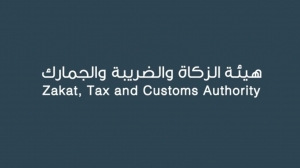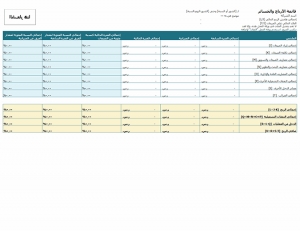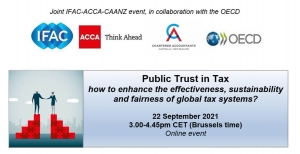عرض العناصر حسب علامة : الضرائب
رسالة ماجستير: دراسة العلاقة بين تطبيق المعايير الدولية لإعداد التقارير المالية IFRS for SME's للمشروعات الصغيرة والمتوسطة المصرية وجودة التقارير والمعلومات المالية والمحاسبية لتحقيق أهداف التنمية المستدامة في جمهورية مصر العربية
هدفت هذه الدراسة إلى دراسة العلاقة بين تطبيق المعايير الدولية لإعداد التقارير المالية (IFRS for SME's) للمشروعات الصغيرة والمتوسطة المصرية وجودة التقارير والمعلومات المالية والمحاسبية لتحقيق أهداف التنمية المستدامة في جمهورية مصر العربية
معلومات إضافية
- البلد مصر
السعودية: نصف المكلفين بـ"القيمة المضافة" يثبتون حلول الفوترة الإلكترونية
قالت هيئة الزكاة والضريبة والجمارك، إن مزودي الحلول التقنية، قاموا بتثبيت حلول الفوترة الإلكترونية المطابقة لمتطلبات المرحلة الأولى (مرحلة الإصدار والحفظ) للفوترة الإلكترونية، لأكثر من 50% من قاعدة عملائهم من المكلفين الخاضعين للائحة الفوترة الإلكترونية.
معلومات إضافية
- البلد الأردن
رسائل ماجستير: مشکلات المعاملة الضريبية لأنشطة وعمليات تکنولوجيا البلوک تشين (Blockchain) فى مصر
لقد شهدت تطبيقات البلوک تشين من الأصول المشفرة والعقود الذکية والعروض الأولية للعملة نمواً قياسيًا في السنوات الأخيرة، مما ترک العديد من المستثمرين ومنصات التداول والمنقبين فى بعض الدول يعانون من عدم اليقين والمفاجأة خلال موسم التحاسب الضريبى، فقد وجد دافعوا الضرائب أنفسهم يواجهون فاتورة ضريبية کبيرة بشکل غير متوقع نتيجة للمفاهيم الخاطئة المحيطة بکيفية فرض الضرائب على هذه المعاملات.
رسالة ماجستير: تحليل العلاقة بين غموض التقارير المالية، أداء المسئولية الاجتماعية، وممارسات التجنب الضريبى، وبين خطر الانهيار المستقبلى لأسعار أسهم الشرکات ذات التصنيف فى مؤشر البورصة المصرية للاستدامة
معلومات إضافية
- البلد مصر
رسالة ماجستير: تحليل العلاقة بين غموض التقارير المالية، أداء المسئولية الاجتماعية، وممارسات التجنب الضريبي وبين خطر الانهيار المستقبلي لأسعار أسهم الشركات ذات التصنيف في مؤشر البورصة المصرية للاستدامة
تمثل هدف القضية البحثية المطروحة من قبل الدراسة الحالية، في اختبار اتجاه وقوة ودلالة العلاقة بين كل من مستوى غموض التقارير المالية، أداء المسئولية الاجتماعية، ودرجة ممارسات التجنب الضريبي، وبين احتمال حدوث خطر الانهيار المستقبلي لسعر سهم الشركة من جهة
5 استراتيجيات لتحسين دائرة الضرائب
حتى قبل COVID-19، كانت القوى الاقتصادية والتنظيمية والاجتماعية غير المسبوقة -بما في ذلك اللوائح التجارية العالمية المعقدة، والتقدم في معايير المحاسبة وتطورات قانون الضرائب العالمي -تدفع الشركات إلى إعادة التفكير في كيفية قيامها بأعمالها. لقد جعل الوباء العالمي الحاجة أكثر إلحاحًا، مما أدى إلى تفاقم التحديات التي تواجه العديد من فرق الضرائب. تقلصت الميزانيات، وتواجه الشركات الآن تغييرات محتملة في معدلات ضرائبها في ظل إدارة جديدة.
جرانت ثورنتون أصدرت تطبيق اختبار الضوابط الرقابية
معلومات إضافية
-
المحتوى بالإنجليزية
Grant Thornton releases controls testing app
By Ranica Arrowsmith
April 14, 2021, 3:37 p.m. EDT
2 Min Read
Facebook
Twitter
LinkedIn
Email
Show more sharing options
Grant Thornton has released a proprietary app for automated controls testing, targeted at auditors.
Cta.x is designed to help audit firms develop and deploy automated internal controls tests to comply with regulations, including from the Sarbanes-Oxley Act. The app from the Top 100 Firm is built to help companies glean insights from their internal compliance efforts and get better return on investment from their controls testing.
Grant Thornton will also be using the app internally. The firm’s risk advisory practice will administer and use the cta.x app as part of its client-service delivery, while the firm’s clients will also be able to directly access and use cta.x.
Web Seminar Execute your data driven audit
The journey toward a fully data-driven audit that utilizes AI begins by first effectively leveraging automation and analytics in your audit workflow.
SPONSOR CONTENT FROM WOLTERS KLUWER
Cta.x was built using proprietary cloud-based software, which an auditing firm or internal auditors at their clients can configure to perform test procedures on controls data. The app is also designed to identify discrepancies before they threaten data quality or business reputation. It accepts controls data that Grant Thornton has mapped to a standard model and allows users to tailor and test procedures for specific control attributes.
“Controls testing is traditionally conducted by a human being assessing evidence and manually analyzing data in a spreadsheet or system for governance, risk and compliance,” said Ethan Rojhani, a partner in the risk advisory practice at Grant Thornton, in a statement. “The cta.x app automates and integrates controls testing by taking existing assurance processes and applying them to the full population of procedures and policies governing controls. It then pipes the data through Grant Thornton’s proprietary logic engine and produces testing results in sophisticated, customizable dashboards.”
“Our app adds intelligent automation at the front end of the controls-testing process," explained Greg Haberer, a senior manager in the Risk Advisory practice at Grant Thornton, also in a statement. "This increases efficiency and shifts the compliance focus from manual tasks, such as data gathering and manipulation, to higher-value activities like anomaly detection and root-cause analysis.”
Firms can deploy cta.x in a client-specific environment within Grant Thornton’s software-as-a-service model, or in the client’s own environment.
The role of alyx
Grant Thornton developed cta.x with the help of alyx, a digital platform recently launched by the firm that uses a “concierge-enabled” system that shares business problems with teams of subject-matter specialists and technologists. It’s through this platform that the firm was able to identify specific pain points in controls testing and develop the idea for cta.x.
Other solutions Gran Thornton has created with the help of alyx include:
te.x — An implementation platform for sophisticated tax engines;
ptvault.x — A platform that helps companies manage personal-property taxes;
SOC.x — A platform to more efficiently produce reports covering System and Organization Controls (SOC reports).
Grant Thornton expects to launch several commercial offerings in the coming months through its alyx platform.
“Our alyx platform is integral to Grant Thornton’s efforts to digitize our clients’ business-critical functions, from risk management to operational efficiency,” said Joseph Brown, Grant Thornton’s national managing partner of market innovation and release management, in a statement. “This is all about identifying the real-world challenges our clients face, and then solving them with cutting-edge solutions that we can scale across disciplines and industries.”
For more information about cta.x, visit www.grantthornton.com/ctax.
نموذج عمل: قائمة الأرباح والخسائر (مع الشعار)
الاتفاقيات الدولية تحفز الانتقال إلى الحد الأدنى العالمي من الضرائب
ما بدأ كإدراك للمشهد الضريبي المتغير الذي أحدثته الشركات الكبيرة التي تحقق إيرادات كبيرة في الأماكن التي لم يكن لها وجود فعلي -وبالتالي لا توجد فيها مسؤولية ضريبية -يتجه نحو حل على المسرح الدولي.
معلومات إضافية
-
المحتوى بالإنجليزية
Int’l agreements spur move to global minimum tax
By Roger Russell
August 09, 2021, 12:10 p.m. EDT
7 Min Read
Facebook
Twitter
LinkedIn
Email
Show more sharing options
What began as an awareness of the changing landscape in tax brought about by large companies earning significant revenue in places where they had no physical presence — and therefore no tax responsibility — is heading for a resolution on the international stage.
After years of discussions, position papers, proposals, negotiations, and re-proposals, both the G7 and G20 met in June 2021 and gave approval to the OECD’s proposals as outlined in its Pillars 1 and 2.
“Years ago, the OECD recognized that there were issues related to digitalization of the global economy, “ said Laurie Dicker, transfer pricing technical tax leader at Top Eight Firm BDO USA. “It was based on the fact that the global tax system is built on the premise of countries having taxing rights where companies have physical presence, and as the economy digitalizes there is the notion that companies are now earning income in places where they do not necessarily have a traditional taxing presence. For example, an entity that sells a digital service, whether entertainment or educational or anything else you can access digitally. Someone can buy that in a country in which they don’t have physical presence. The servers can be anywhere, so the companies generate income from someone buying the service but the county does not get taxing rights. That’s the backdrop.”
Advances in Tech brings together some of the latest software and technologies that are helping the industry move forward.
ACCOUNTING TODAY
A long time coming
The OECD has been discussing this for years, beginning in 2013 with its identifying “Base Erosion and Profit Shifting,” or BEPS, as an issue that needed to be addressed.
“They finally started introducing proposals on how to address this,” said Dicker. “The proposals have been refined over time.”
The BEPS project was initiated in 2013; BEPS final reports were issued in October 2015; BEPS 2.0 interim reports came out in 2019; blueprints for a new global tax framework came out in October 2020; and the G7 meeting in June 2021 agreed to the OECD framework.
“There’s been an enormous amount of activity this year,” said Dicker. “What caught everyone’s attention was the G7 meeting in early June this year, when they met in person and issued a statement in support of what the OECD proposed. That was a huge opening.”
Weeks later, the G20 met and also agreed to the proposals.
“What has been proposed is a two-pillar approach,” said Dicker.
Pillar 1 involves reallocation of profit and revised nexus rules, and is concerned with what portion of profits should be taxed in the jurisdictions where clients or users are located. Pillar Two contains an anti-base erosion mechanism in order to ensure that multinational enterprises pay a minimum level of tax.
“Pillar 2 will expand the taxable revenue collected globally from corporations by implementing a global minimum tax,” said Dicker. “They’re talking about a minimum rate of 15%. The exact rate has not been decided yet. If a country where the effective tax rate is below 15%, then the home country where the company is located can tax on the difference. For example, if a U.S. multinational is taxed in Ireland at 12%, then the U.S. can impose a tax to bring that company up to the global rate. For any country that has a rate below15 %, the choice is to raise their rate or forgo the tax revenue and hand it over to the parent to the parent country. Companies will be paying the same rate; it’s just a question of where they will pay it.”
“Prominent low-tax countries are against this and countries continue to negotiate,” said Dicker. Among the countries that have not yet agreed are Ireland, Hungary, Estonia, Kenya, Nigeria, Sri Lanka and Barbados. “They each have their own reasons for not agreeing,” said Dicker.
Pillar 1 is far more complicated, according to Dicker. “It redefines taxing rights and proposes a new allocation methodology. If you develop a product in one country, manufacture it in another country, market it in another country and have customer service and warehouses in other countries, it determines what part of revenue is allocated to each of those activities.”
Randy Buchanan, a partner at law firm Eversheds Sutherland, agreed.
“Pillar 1 is a much more difficult exercise — it’s a bigger departure from how international tax has been handled in the past, when you always needed some type of physical connection to a country to be taxed in that country. Pillar 1 is going in the direction of saying that if you sell goods or services into a country then you’re subject to tax in that country even if you have no physical presence there. It would shift the right to tax profits away from source countries and into destination countries, and that’s a lot easier said than done. To make it work you really need an agreed formulary apportionment mechanism to determine who ends up taxing how much of the profit. The details of how to accomplish that are pretty murky, and even assuming you could get everyone on the same page, actually implementing it is not going to be easy.”
It will be particularly difficult to implement in the U.S., Buchanan observed. “It will take some type of multilateral treaty among the various countries,” he said. “To get two-thirds of the Senate to ratify that kind of multilateral treaty seems like a steep uphill climb, given the lack of Republican support. You could try to implement some aspects of this through legislation, but it’s not clear to me how you would implement it without a treaty.”
”One way to think about it is that it’s taking the global tax system and trying to make outlook more like the state and local system here in the U.S., where states apply similar apportionment factors to determine which state has the right to tax income,” he explained. “It’s easier to do in a country where you have a unified central government, but it’s harder in the international stage where there’s no central government. The OECD in essence is trying to perform that kind of centralized function to get countries together, but it doesn’t have any real authority. Every country is doing it on a voluntary basis, with no external constraints around implementing it such as the U.S. Constitution.”
Pillar 1 generally would apply disproportionally to U.S.-based multinationals, Buchanan observed. “It goes beyond digital and high-tech entities,” he noted. “Most of the companies that would be impacted by Pillar 1 are large U.S. multinationals, which is another reason I don’t see bipartisan support developing in the U.S.”
Treasury Secretary Janet Yellen during the G20 finance ministers and central bankers meeting in Venice.Andreas Solaro/AFP/Getty Images
Local opposition
Kevin Brady, R-Texas, the top Republican on the House Ways and Means Committee, stated on July 1, 2021, “In negotiations with the OECD, the Biden administration has a already given up significant U.S. ground by opening the door to not grandfathering GILTI and agreeing to a global minimum tax structure that favors foreign-headquartered companies and workers over American ones. This is a dangerous economic surrender that sends U.S. jobs overseas, undermines our economy, and strips away our U.S. tax base.”
“Politics makes strange bedfellows,” Buchanan observed, noting that the large companies in the crosshairs of Pillars 1 and 2 are primarily supporters of Democrats. “Not all Democrats think it’s a great idea, but the administration is supporting it so at least they have a higher comfort level,” he said.
Loren Ponds, a member at law firm Miller & Chevalier, agreed. “Certainly this administration has been active in the negotiation process,” she said. “The Treasury Department was able to work with the Inclusive Framework members [the group of countries working to solve BEPS issues] so now there is a proposed 15% rate, which is lower than the proposed rate for GILTI.”
The fact that individual countries were going ahead and enacting their own Digital Services Tax spurred the push to move the OECD agreement ahead, Ponds indicated: “They knew they were working against the clock.”
Things will start moving quickly now, predicted BDO’s Dicker. “Nothing was going to happen unless the U.S. came on board. Then Treasury Secretary Yellen came out in support, but with a simplified method of what would be in scope. There will be a meeting of G20 principals in October, and the OECD will release its final blueprint of Pillars 1 and 2. It’s possible that changes will need to be implemented at three levels — regulatory, legislative, and by treaty. Each country will have a different process, but the OECD is hoping that it can be implemented globally and take effect in 2023, but experts view this as overly optimistic. To the extent it happens, it will be the largest change to the global tax landscape in 100 years.”
حدث: ثقة الجمهور في الضرائب، كيف يمكن تعزيز فعالية واستدامة وعدالة النظم الضريبية العالمية؟
معلومات إضافية
- البلد عالمي
- نوع الفعالية مجانا
- بداية الفعالية الأربعاء, 22 سبتمبر 2021
- نهاية الفعالية الأربعاء, 22 سبتمبر 2021
- التخصص ضرائب
- مكان الفعالية أونلاين










